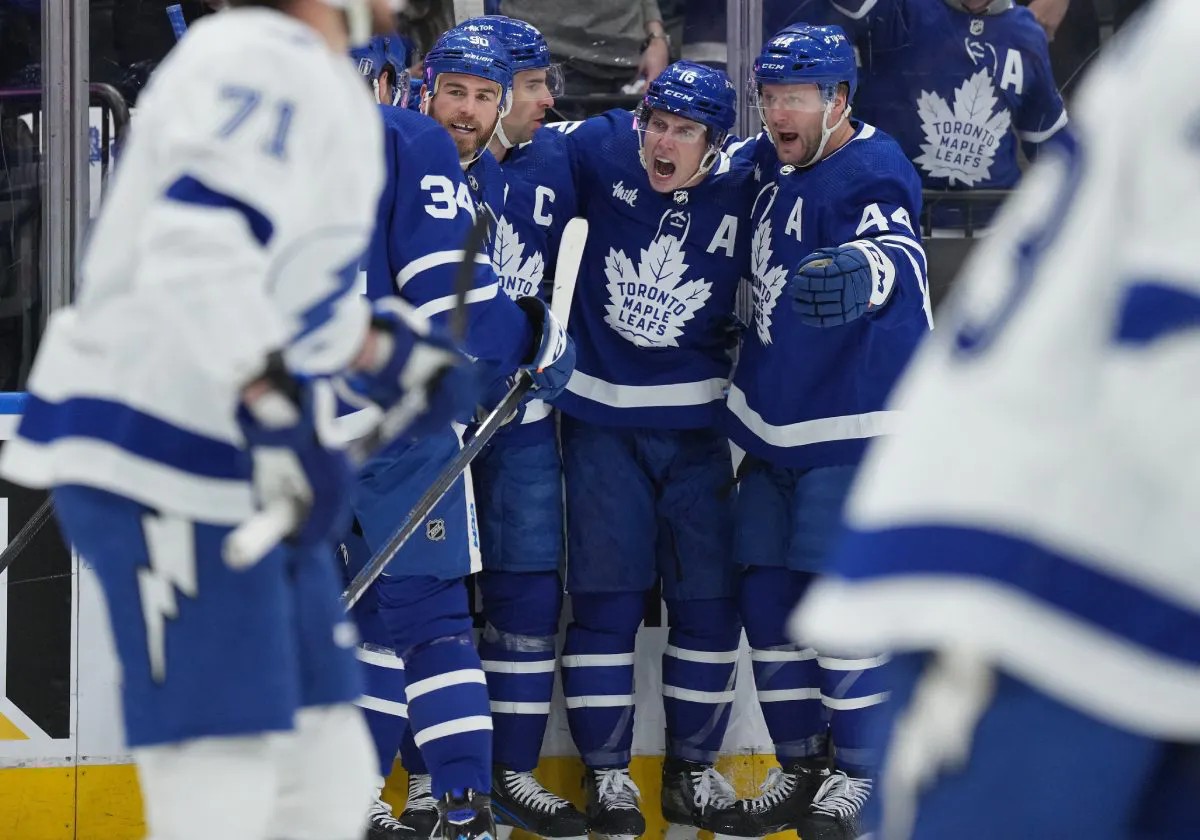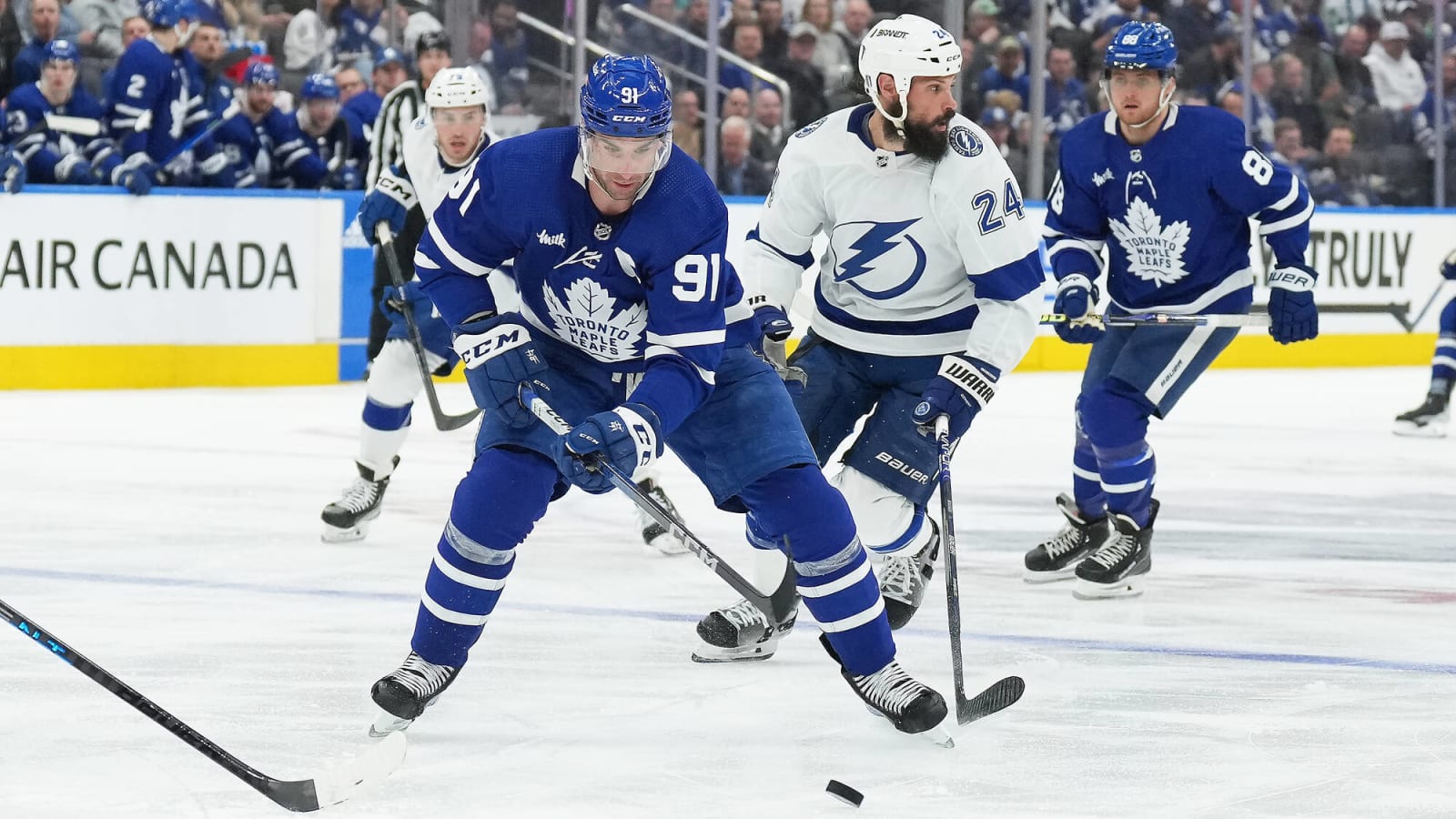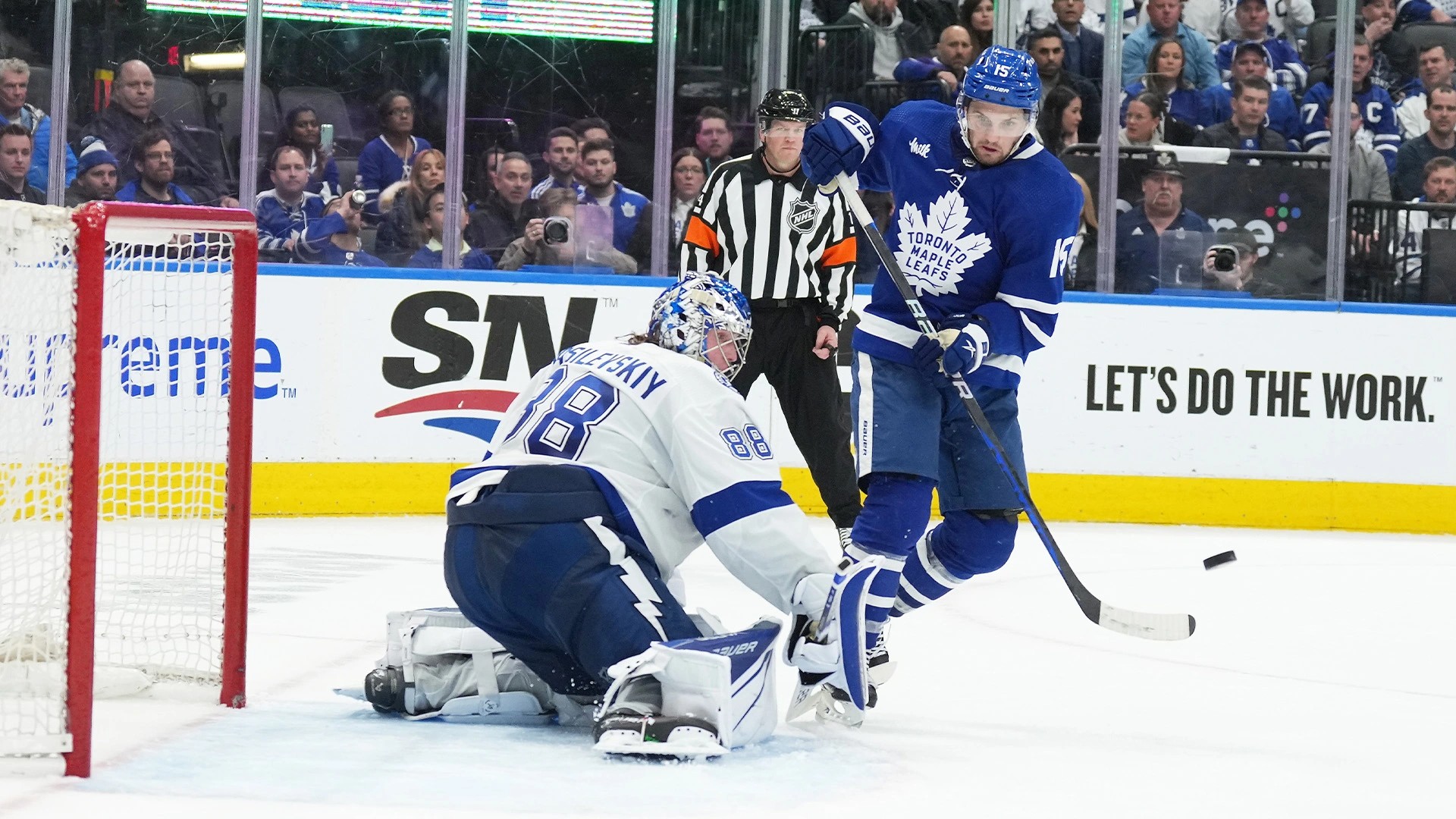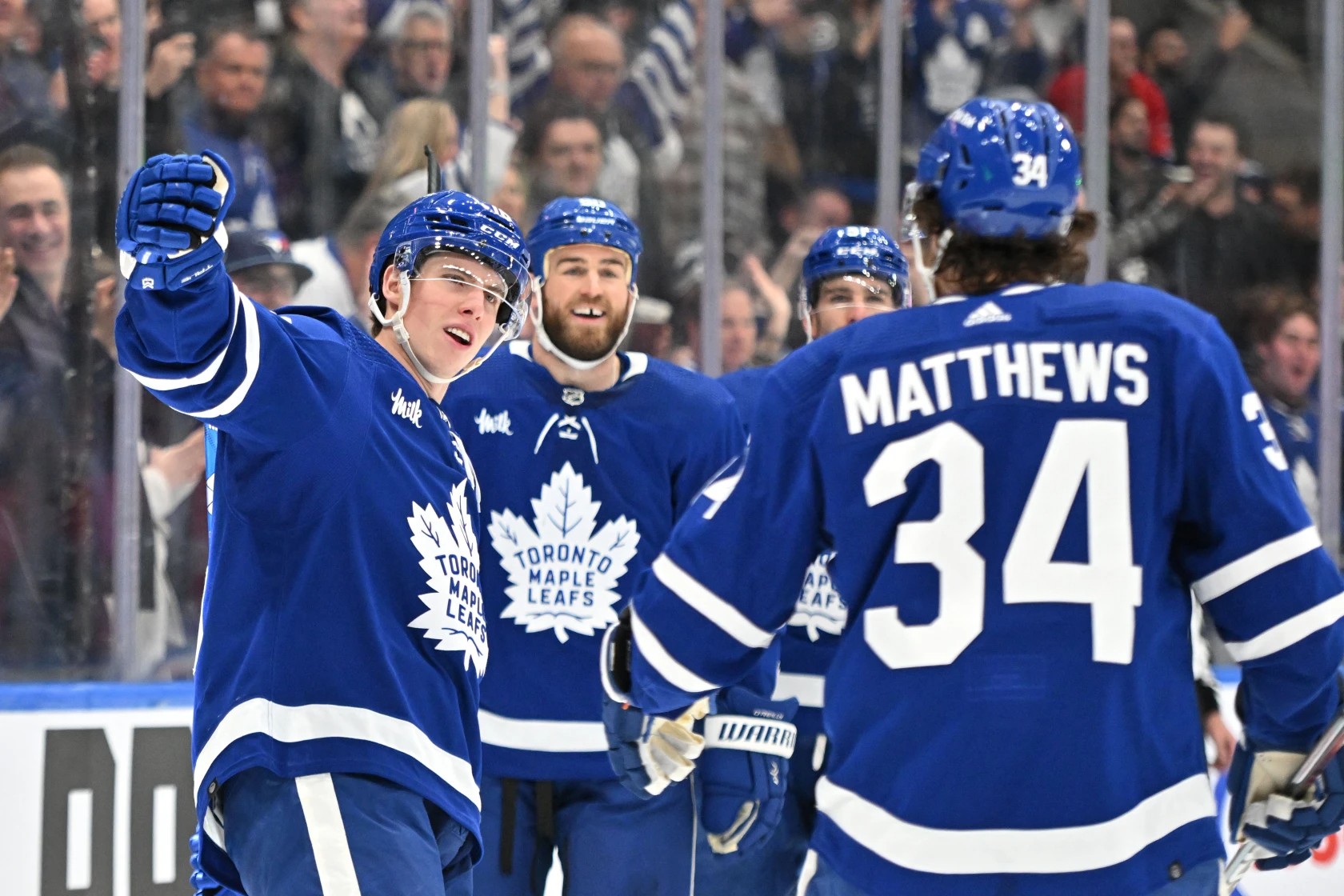After Game 1’s near-worst-case scenario, the Maple Leafs answered in Game 2 with a resounding win.
With the Tampa Bay Lightning massively shorthanded on defense, it was one the Leafs needed desperately, and their core players delivered. John Tavares’ hat trick was the headliner, but multiple stars had monster games to power the team to a 7-2 victory.
This will be a much cheerier piece for Leafs fans to read — a stark contrast to Game 1’s post-game analysis of “everyone was bad” to “most everyone was good.” Just like last time, we’ll be breaking down the biggest moments in the game, the key performances, and talking about some storylines for Game 3.
Turning Points

How about a turning point that begins with the very first shift? Sheldon Keefe started with his top line against the Cirelli line for Tampa, the Leafs shot it in deep, and when the Lightning went to break it out, Mitch Marner jumped a passing lane and got yanked down to give the Leafs a power play just 40 seconds in.
Marner’s interception was an excellent play and a notable departure from how the Leafs were approaching the game in the first game. What stood out on re-watch of Game 1 was how passive Toronto was — putting no pressure on Tampa’s breakouts at all, sitting back in the neutral zone and doing nothing to slow the Lightning down through the center of the ice, and sagging back massively on zone entries in the DZ. Marner biting down hard at the OZ blue line to pick a puck off announced very early that it was going to be a different sort of game both tactically and in terms of the team’s overall mindset.
What he did on the ensuing power play also announced how different of a game it was going to be. Ryan O’Reilly won the draw, Auston Matthews got it to the point, Morgan Rielly moved it over, and Marner walked in and fired a shot by Andrei Vasilevskiy. Most of this turning point is thanks to Marner, but some of it is on Vasilevskiy, too.
This was not a great goal for the Lightning goalie to give up — an unscreened slapshot that beats him five-hole, one without the velocity of, say, a Zdeno Chara blast. Maybe Vasilevskiy was actually surprised by Marner’s shot given his pass-first tendencies — in which case, well done from #16 for showing the confidence to shoot and playing against type. With the first goal, the Leafs were off and running, and Marner’s early tally powered them to a strong first period.
The second turning point came on the Lightning’s first goal of the game. The Leafs were leading 3-0 at that point and bludgeoning the Bolts, hemming them in for long stretches at a time with several Grade A scoring opportunities. Matthew Knies got a look in tight, Noel Acciari had a chance all alone, and Alex Kerfoot was robbed on a point-blank chance.
The Leafs couldn’t make it 4-0, and the Lightning responded with a goal of their own, no doubt causing a collective *gulp* in Leafs Nation. Ryan O’Reilly was walled off at the blue line by Ian Cole and knocked down, creating a 4v2 the other way for Tampa. William Nylander backchecked well to make it a 4v3, but Nylander and Giordano took the same guy and neither stopped the pass, which Stamkos made to Cole. Ilya Samsonov bit hard on the pass and was in a tough spot, while Justin Holl got carved up by Cole, who finished in tight. Just like that, momentum was flipped and it was a real hockey game again.
This leads us to the final turning point: John Tavares’ big answer with the game at 3-1. The Lightning had strung a couple of solid shifts together and seemed to be building on their first tally of the night. Toronto needed a response.
It came on a neutral zone play, a turnover by Cole that was intercepted by Luke Schenn. Nylander took charge, picked the puck up basically directly off of Schenn’s stick, zoomed right by Ross Colton, and took all the ice available to him with the Lightning ceding their blue line. Morgan Rielly activated into the rush and Nylander handed it off to #44, who shot it toward the net in a tough spot for Vasilevskiy.
The goalie’s only option was to kick it out right into loose ice, where John Tavares was waiting. The captain flipped it over Vasilevskiy’s shoulder and beneath the bar to put the Leafs ahead 4-1. Their stranglehold on the game was restored, and the fourth goal went straight to the Leafs’ legs en route to a never-in-doubt victory from there.
The Maple Leafs got the mojo back on the forecheck, and just under three minutes later, the fourth line churned out a goal that put the game to rest before the second intermission. A metaphorical knockout blow had been delivered and the Leafs had responded.
Notable Performances

This was how I ended my Game 1 analysis piece: “If (the Leafs) can’t come away with a victory, it starts to feel like pack-it-up time on the season… and possibly this core. No pressure.” Well, the core showed up in full force in Game 2.
It’s an unusual game because there are three players with massive achievements who all merit starting the discussion and I’m not sure who is the correct one to go with. I’ll go in descending order of jersey number and begin with John Tavares, who has taken a beating from certain members of the Leafs media.
He scored two goals at 5v5 tonight, which was an area of his play that had dipped noticeably since Sheldon Keefe made the rather questionable decision of splitting up Marner and Tavares, a combo that had worked for so much of the year. Tavares’ line has to find a way to be effective at even strength and they were tonight; expected goals, scoring chances, and high-danger chances were all in their favor per Natural Stat Trick.
More importantly, actual goals were in their favour. They scored two and didn’t allow any against, which is exactly what you want to see. Tavares won two-thirds of his faceoffs on the night, tied for the team lead with six shots on goal, and put three of them by Vasilevskiy. And his elite ability to finish beneath the top of the circles. His shot on the first goal was a genuine rip (through a nice screen from Alex Kerfoot), the second wasn’t as easy as he made it look, and the third was Tavares also at his best, finishing in tight on the power play.
Tavares got a bit of a gift from Zach Bogosian making the decision to finish a check in the corner while shorthanded on a 5v3 kill, which allowed Tavares tons of room to walk in tight all alone. Still, he managed to put the puck through the goalie’s legs and got rewarded when Vasilevskiy unknowingly knocked it into his own net with his leg. With the hat trick — a big-time statement — Tavares already has four goals in two games to start the series.
Next up is Morgan Rielly who had four primary assists. Something that I, and my MLHS colleagues Anthony Petrielli and Alec Brownscombe, had brought up frequently during the regular season when Rielly attracted the ire of the fanbase is that he has been one of Toronto’s most consistent playoff performers over the run of this core. That continued tonight.
Rielly’s first assist on the Marner goal was perfunctory, but his next three were all big-time plays. The set play to tee up Tavares in the slot was beautifully executed by Rielly, his primary assist on the Nylander goal was a phenomenal cross-ice pass that gave #88 space to set up for his lethal wrist shot, and then the assist on the second Tavares goal was a shot placed in a perfect spot that left Vasilevskiy no choice but to kick it to the captain.
MLHS contributor Zach Payne brought up a good point in my conversations with him last night, saying that Rielly’s natural ability to join the rush and create offense in transition takes on much greater importance in the postseason when rush chances are reduced and the checking is tighter. That was the case on the second Tavares goal tonight and was also the case in the game-tying goal in Game 7 last year when Rielly rushed up with Marner and Matthews. Rielly’s ability to drive offense stands out in the playoffs and he raises his game defensively, too. His pair with Luke Schenn has been rock solid through two games.
The third big-name shoutout has to go to Mitch Marner, who is the third to be mentioned tonight despite a two-goal, three-point night. Marner owned that first minute of the game and then scored a second goal later on an evening when everything was going Toronto’s way, whipping a puck toward the net that went in off Brandon Hagel’s body. He also picked up a primary assist on the Tavares hat trick goal while on the PP — a really nice play by Marner in the corner to recover the puck and knife it to Tavares, drawing Bogosian in and clearing out space for the captain to go to work.
Marner’s line still has more to unlock at 5v5, although that has more to do with his linemate (more on that in a second), and it’s awfully hard to complain about him providing effective defense and putting up a 2-4-6 line in two games to begin the series.
Beyond those three, William Nylander had a nice evening yet again with the third goal while the Leafs were 6v5 during a delayed penalty. It’s the sort of save you expect Vasilevskiy to make, but I’ll give Nylander credit for ripping a well-placed shot. He helped create the second Tavares goal by picking the puck up with aggression in the center ice area and leading the entry as well to earn an assist. Dating back to the Montreal series, Nylander has 10 goals and 18 points in his last 16 playoff games. Hard to complain about that kind of production.
The one core member who does need to find another level — and is the factor with the biggest upside potential for the Leafs moving forward — is Auston Matthews. The Leafs are 1-1 in a series where Matthews hasn’t taken over a game yet. After closing the regular season on a tear, he’s been pretty quiet offensively in these first two games. He has four assists so far — and his play to keep the puck alive and not let Tampa touch up on the Nylander goal was big — but when healthy and rolling, Matthews is the best goalscorer on earth.
#34 sure looked healthy down the stretch, so the Leafs need him to be that level of goalscorer in this series. Other players stepping up has buoyed them so far, but #34 announcing his presence and leading the team to a win on Saturday would be a welcome sight. Tampa is devoting lots of attention to Matthews, sure, but he needs to erupt at some point in the next game or two.
I’ll also give the third line of Matthew Knies, Ryan O’Reilly, and Noel Acciari one big shoutout right now. They were phenomenal — Toronto’s best line at 5v5, in my opinion — even if they didn’t actually score any goals. All three forwards had opportunities to, but each were the victim of a robbery by Vasilevskiy. Acciari was flying around the ice, banging bodies, and he got a chance all alone. O’Reilly had several looks, one of which led to Vasilevskiy’s best save (coming in garbage time at the end of the game), and Knies had a couple of opportunities. This play from the rookie had everyone in Leafs Nation buzzing:
Keep Matthew Knies in the lineup pic.twitter.com/zsCaPaRbsT
— Michael (@mic_mazz) April 21, 2023
We’ve now seen Knies do this twice as a pro, previously against the Rangers in the final regular season game when he toasted Braden Schneider in a similar manner. Knies may not be the fastest north-south skater, but he has the agility and is powerful on his edges, capable of putting defenders in the spin cycle on a dime to create space for himself.
Knies looks every bit the part of an NHLer right now; his mature frame gives him the strength a lot of college players lack when they make the jump to the NHL. That has allowed him to win a lot of puck battles in the corners, and he was a big part of his line crushing Tampa on the forecheck.
I don’t want to downplay O’Reilly’s contributions, either, as he was really strong. It’s RO’R driving the line and dictating play, even if his wingers are doing great work assisting by digging in the corners and recovering pucks. There were lots of questions in the buildup to the trade as to whether O’Reilly is still the same player, but right now he looks every bit as good as he was in 2021-22 in St. Louis, which is a terrific player and a real matchup problem for Tampa on his own line. When a line outshoots the opposition 9-1 at 5v5 and owns 80%+ of the expected goals and high-danger chances, the whole line deserves a round of applause.
The fourth line might have been the most interesting story on the evening, creating a goal of their own which was cashed in by Zach Aston-Reese. A lot of this game was hard to decipher moving forward since Tampa Bay was down two of their top four defensemen, but that goal was legitimate since it came against the Lightning’s top line and their only pair to stay the same from Game 1, Mikhail Sergachev and Darren Raddysh.
The Leafs’ fourth line was out there against the Point line for a DZ draw, provided fine defense, chipped it out, and dumped it in. Sam Lafferty and ZAR went in after it against Raddysh and Sergachev, won the battle, and got it to David Kämpf, who shot it on net. Vasilevskiy made the save, but Aston-Reese boxed out Sergachev in front and tapped it in.
The Leafs received one goal from anyone on their fourth line all of last series, and it came from Colin Blackwell on a rush just off a penalty kill when the line wasn’t even playing together properly. From that perspective, the fourth line has already been more productive this year. I’ll have more to say about this group in the storylines section.
On defense, I gave a quick mention to Rielly-Schenn already. Jake McCabe and TJ Brodie were rock solid, soaking up big minutes and doing just fine. Tampa’s top line created one goal, and it came with those two on the bench.
Brodie was terrific after a tough Game 1, and I thought McCabe was quite good as well beyond one stupid penalty early in the game when he punched Corey Perry after the whistle. McCabe has got to cut down on that sort of stuff and play cleaner games here in the postseason.
Mark Giordano and Justin Holl were still not at their best tonight, but they were better. Holl was not solely at fault for the first goal, but it wasn’t a great shift from him in general in the leadup. Giordano also defended that rush a little oddly and was on ice (with McCabe) for the meaningless Perry goal late, failing to take the pass away. Giordano looks a bit tired right now, and it’s something to monitor as the series shifts to Tampa.
Finally, we arrive at Ilya Samsonov. The Leaf netminder was much better in Game 2 after his ugly performance in the opener. I don’t think he was incredible — and it still feels like he has another level of comfortable he can get to in these playoff games — but he was much calmer and steadier. He was not sliding around as much; there were a few rebounds early, but nothing crazy (the Lightning were also shooting a ton in the first 10 minutes to hunt rebounds).
He made one massive save on the PK for the Leafs early on when Nikita Kucherov fired off one of his signature shot-pass fakes to set up Brayden Point in the slot. Samsonov adjusted very well to make a blocker stop and it could’ve qualified as a turning point itself, frankly. The Maple Leafs were dominant in front of him, but Samsonov was solid himself. Back on track.
Storylines for Game 3

1. The health of the Lightning. This is a big unknown going into Game 3, after both Victor Hedman and Erik Cernák missed Game 2. Hedman was skating in practice, so you have to think he’s close enough to give it a go. With Cernák, it’s much less clear due to the nature of the injury (head), and he was not skating in practice. It’s quite possible he may not play be ready to go in Game 3.
The Lightning also saw Anthony Cirelli get banged up during the game. Tampa will likely have a fuller lineup for Game 3, but it may include a number of key players playing at <100% (Hedman included).
Game 2 showcased why they need at least one of Hedman and Cernák back. Both are big, physical, heavy defensemen who clear the net front and defend the high-danger areas very well. They are also assets in the corners as cycle-breakers. Without them, Tampa was forced to ice a lineup including Nick Perbix, Darren Raddysh, Hadyn Fleury, and Zach Bogosian, all of whom are 6/7 types or borderline AHL-level players. The Leafs abused them relentlessly in the corners and around the net, caving in Tampa in the Lightning end in that second period.
Even Mikhail Sergachev is not really a matchup defensive defenseman, which was showcased in Game 2. Even if the Lightning are healthier going forward, the Leafs need to stay aggressive on the forecheck to exploit any further vulnerabilities and wear down their fraying defense.
2. Special teams. In Game 2, we saw the Leaf penalty kill play a much stronger game than the first one, killing all man advantages, including two big ones in the first while leading only 1-0. Samsonov’s save was part of it, but they were decent on entry defense and shot blocks played a sizable role — Justin Holl, in particular, made a couple of big ones.
The power play remains hot — a very optimistic indicator through two games so far — and is creating plenty of good looks. The Leafs got two more PPGs in Game 2 and had a third while on a delayed penalty, so playing with the man advantage has not been a problem so far. In terms of the special teams battle, it’s been an encouraging first two games, but we’ve seen this flip before as series have worn on in the past, and it needs to be sustained this time around.
3. Ilya Samsonov on the road. For much of the year, a lot was made about the home/road splits of Matt Murray and Samsonov, with Murray drastically better on the road and Samsonov drastically better at home. Samsonov’s road stats did improve quite a bit, but there is still a bit of a gap (.909 vs. .927).
Tampa Bay is a fearsome rink to play in and the Lightning were much better at home than on the road this season. It will be an intimidating scenario. Samsonov will need to rise to the occasion, settle a game down in a hostile venue, and silence the Tampa partisans. After losing one at home, Toronto will have to take one game in Tampa at some point to win this series.
4. The fourth line vs. tough matchups? One of the interesting subplots of this game was Sheldon Keefe’s willingness to let the David Kämpf line take on the Tampa Bay Lightning’s best players. The Leafs had a number of shifts, including several coming off faceoffs (when Keefe had the ability to choose matchups), in which Kämpf’s fourth line started against the Brayden Point top line of Tampa.
It wasn’t always perfect, but the Kämpf line did okay in the underlying metrics, hanging in there and eventually creating a goal. Now as the series shifts down south, Keefe will not have last change but we seemed to get an indication of him comfortable with this matchup playing out.
5. Toronto’s shooters and Andrei Vasilevskiy. The Tampa netminder is a terrific, all-world goalie, but the Maple Leaf shooters have not had too much trouble beating him over the past two seasons when they get dangerous looks. Yes, Vasilevskiy held them to one goal in Game 7 last year, but I’d argue that was more a testament to the Lightning defense than Vasilevskiy as Toronto was constantly held to the perimeter and took a lot of low-danger shots. Indeed, two of the only great looks they got in that game last season both resulted in pucks beating Vasilevskiy (only one counted because of the fated Justin Holl interference penalty).
If you look at the past two regular seasons + the two playoff series to this point, here are the goals against for the Leafs against Vasilevskiy: 2, 3, 6, 1, 5, 3, 3, 3, 4, 3, 1, 3, 2, 4, 3, 7 (average of 3.3 goals per game). The two one-goal performances are G7 as well as that 8-1 drubbing the Lightning gave the Leafs right before the playoffs last season, which was a dreadful effort by the team all around. Vasilevskiy was bad in Game 2 — and I fully expect him to be better in Game 3 — but in totality, this is not a goalie who is repeatedly stymying the Leafs.


![Sheldon Keefe on the Maple Leafs’ struggling power play: “[We’ve scored] one out of 11 high-danger chances in tight to the net… We have been in those spots and haven’t converted” Sheldon Keefe, playoff press conference](https://mapleleafshotstove.com/wp-content/uploads/2024/04/keefe-pc-game-3-218x150.jpg)

![Jim Montgomery Post Game, Bruins 4 vs. Leafs 2: “[Marchand] still manages to get under people’s skin, yet he doesn’t cross the line” Jim Montgomery, Boston Bruins post game](https://mapleleafshotstove.com/wp-content/uploads/2024/04/jim-monty-pg-to-218x150.jpg)























![Sheldon Keefe on the Maple Leafs’ struggling power play: “[We’ve scored] one out of 11 high-danger chances in tight to the net… We have been in those spots and haven’t converted” Sheldon Keefe, playoff press conference](https://mapleleafshotstove.com/wp-content/uploads/2024/04/keefe-pc-game-3-100x70.jpg)



![Jim Montgomery Post Game, Bruins 4 vs. Leafs 2: “[Marchand] still manages to get under people’s skin, yet he doesn’t cross the line” Jim Montgomery, Boston Bruins post game](https://mapleleafshotstove.com/wp-content/uploads/2024/04/jim-monty-pg-to-100x70.jpg)

